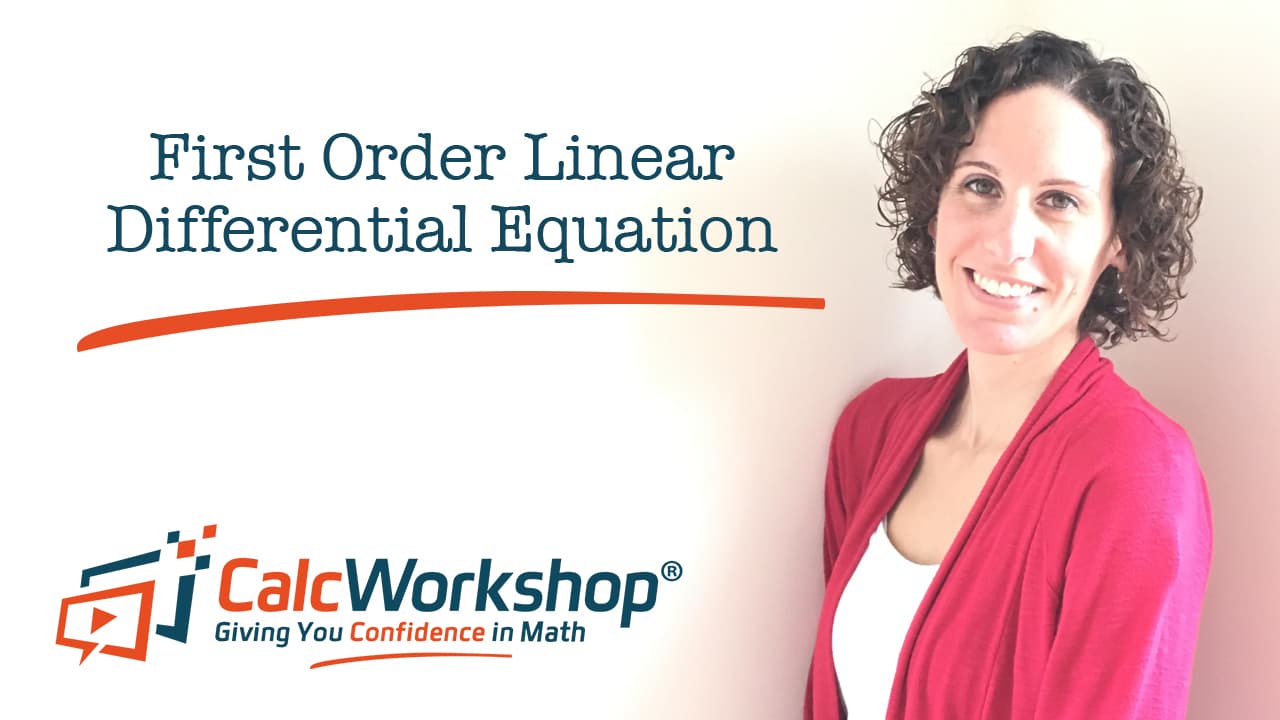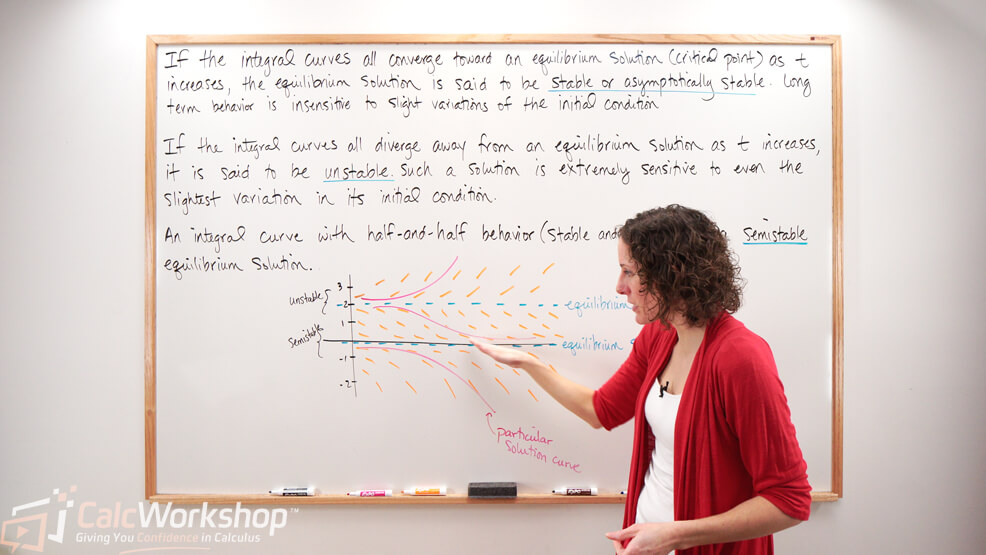First order differential equations got you stumped? Discover the integrating factor method, one of the most effective techniques for tackling them!

Jenn, Founder Calcworkshop®, 15+ Years Experience (Licensed & Certified Teacher)
Since not all differential equations are separable, they need to be transformed before being solved.
The secret?
Multiply the differential equation by a specific function, \(\mu(\mathrm{t})\), known as the integrating factor. This transforms the equation into one that’s instantly integrable using the product rule for derivatives.
Exciting, right?
Let’s dive into this incredible method!
Linear First Order Differential Equations
Okay, so a linear first order DE is an equation of the form
\begin{equation}
a_1(x) \frac{d y}{d x}+a_0(x) y=g(x)
\end{equation}
And by dividing both sides of the equation by the leading coefficient we get
\begin{equation}
\frac{d y}{d x}+\frac{a_0(x)}{a_1(x)} y=\frac{g(x)}{a_1(x)}
\end{equation}
Which is more commonly written as
\begin{equation}
\frac{d y}{d x}+P(x) y=Q(x)
\end{equation}
Why is this important?
Because, once we have established that we have a first order linear equation in the form seen above, we can employ the integrating factor process!
Steps for Solving Linear Differential Equations
- Put the DE in the standard form \(\frac{d y}{d x}+P(x) y=Q(x)\)
- Find the integrating factor \(\mu(x)=e^{\int P(x) d x}\)
- Multiply everything in the DE by the integrating factor and verify the left-hand sides becomes the product rule \(\frac{d}{d x}[\mu(x) y(x)]\)
- Integrate both sides, with the help of FTC#2, and place constant of integration on the right-hand side.
- Solve for \(y(x)\) and indicate interval of validity.
I know this may seem tricky, but don’t worry, the following example will help make sense of things.
Example: Solving a First Order Linear Differential Equation
Solve the differential equation \(\frac{d y}{d x}+3 x^{2} y=6 x^{2}\).
Step 1: Check DE Type & Standard Form
First, we should check to see if the given differential equation is separable, because if so, that is the easiest solving method to employ.
Unfortunately, it is not. But it is first-order and linear; therefore, we can use the integrating factor method.
Alright, so our first step in using integrating factors is to ensure the equation is in standard form \(\frac{d y}{d x}+P(x) y=Q(x)\), which it is.
\begin{equation}
\frac{d y}{d x}+\underbrace{3 x^2}_{P(x)} y=\underbrace{6 x^2}_{Q(x)}
\end{equation}
Step 2: Find the Integrating Factor
Next, we will find our integrating factor knowing that \(\mu(x)=e^{\int P(x) d x}\), where \(P(x)=3 x^{2}\)
\begin{equation*}
\mu(x)=e^{\int\left(3 x^{2}\right) d x}=e^{x^{3}}
\end{equation*}
Step 3: Multiply DE by Integrating Factor
Now we will multiply both sides of the differential equation by \(\mu(x)=e^{x^{3}}\), and get
\begin{equation*}
\begin{aligned}
& e^{x^{3}}\left(\frac{d y}{d x}+3 x^{2} y=6 x^{2}\right) \\
& e^{x^{3}}\left(\frac{d y}{d x}\right)+e^{x^{3}}\left(3 x^{2} y\right)=e^{x^{3}}\left(6 x^{2}\right)
\end{aligned}
\end{equation*}
Now we must verify that the left-hand side of the equation is actually the product rule for derivatives in disguise.
\begin{equation}
\frac{d y}{d x}[\mu(x) y(x)]=\underbrace{\mu(x)}_{e^{x^3}} \underbrace{y^{\prime}(x)}_{\frac{d y}{d x}}+\underbrace{\mu^{\prime}(x)}_{3 x^2 e^{x^3}} \underbrace{y(x)}_y
\end{equation}
Which means we can rewrite the equation as
\begin{equation*}
\frac{d y}{d x}[\mu(x) y(x)]=6 x^{2} e^{x^{3}}
\end{equation*}
Step 4: Integrate Both Sides
All that is left to do is integrate both sides, by utilizing u-substitution.
\begin{equation}
\int\left(\frac{d y}{d x}[\mu(x) y(x)]\right) d x=\int\left(6 x^2 e^{x^3}\right) d x
\end{equation}
\begin{equation}
\int\left(\frac{d y}{d x}\left[e^{x^3} y\right]\right) d x=\int\left(6 x^2 e^{x^3}\right) d x
\end{equation}
\begin{equation}
e^{x^3} y=\int\left(6 x^2 e^{x^3}\right) d x \quad \begin{aligned}
u & =x^3 \\
d u & =3 x^2
\end{aligned}
\end{equation}
\begin{equation}
e^{x^3} y=\int\left(2 e^u\right) d u
\end{equation}
\begin{equation}
e^{x^3} y=2 e^u+C
\end{equation}
\begin{equation}
e^{x^3} y=2 e^{x^3}+C
\end{equation}
Step 5: Solve for \(y(x)\)
Finally, we find our general form by solving for \(y\).
\begin{equation*}
\begin{aligned}
& y=\frac{2 e^{x^{3}}}{e^{x^{3}}}+\frac{C}{e^{x^{3}}} \\
& y=2+C e^{-x^{3}}
\end{aligned}
\end{equation*}
That’s it!
And the more you see this process in action, the easier it will become.
Get ready to:
- Master the integrating factors method for solving first order linear differential equations
- Tackle both general and particular forms
- Learn various integrating techniques and definite integrals for initial value problems
- Determine the largest interval where the solution is defined
Dive in and feel confident solving these equations with ease!
Video Tutorial w/ Full Lesson & Detailed Examples

Get access to all the courses and over 450 HD videos with your subscription
Monthly and Yearly Plans Available
Still wondering if CalcWorkshop is right for you?
Take a Tour and find out how a membership can take the struggle out of learning math.